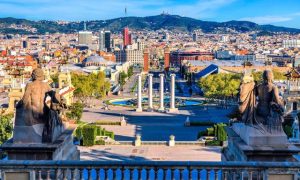Italy, the cultural and artistic center of Europe, with its stunning landscapes, delicious food, and long history, attracts people from all over the world toimmigrants. Whether it's for a better quality of life, quality educational resources, or the realization of an entrepreneurial dream, theImmigration to Italyare ideal for many people. However, the process from visa application to eventual permanent residency requires a thorough understanding of the policies and steps involved. This article will provide you with a detailedItaly Immigration TipsThe
I. Understanding Italian Visa Types
Before applying for immigration, you first need to identify the type of visa that is right for you. Here are a few of the main types of Italian visas:
1. work visa
For applicants who have already found a job in Italy. The employer has to submit an application to the Italian labor authorities and obtain approval through the Labor Demand Quota Program.
Suitable for people: Foreigners with specialized skills or employed by Italian companies.
2. Investment Visa (Golden Visa)
Residency is obtained through investment, and common ways include investing in government bonds, real estate, or businesses.
Suitable for people: High Net Worth Individuals (HNWIs) or those who wish to acquire status through investment.
3. family reunification visa
For immediate family members to apply for reunification with family members residing in Italy.
Suitable for people: Spouse, minor children and dependent parents.
4. student visa
For students admitted to an Italian university or educational institution.
Suitable for people: International students wishing to further their studies in Italy.
5. business start-up visa
For those who plan to start a business in Italy. Applicants are required to submit a business plan and have it approved by the Italian Ministry of Economic Development.
Suitable for people: Innovative entrepreneurs with business plans.
II. Basic steps for visa application
Regardless of which visa you choose, the application steps usually include the following:
1. Preparation of application materials
Depending on the type of visa, you will need to prepare different documents. Common documents include:
- Valid passport;
- Fill out the completed visa application form;
- Certificate of no criminal record;
- Proof of financial capacity (bank deposits or proof of income);
- Proof of housing (e.g., rental contract or proof of purchase).
2. Submit an application
Submit your visa application at the Italian Consulate or Embassy in your country. Some visa types require an online appointment and payment of the visa fee.
3. audition
Certain visas may require an interview to verify the applicant's background and intent to apply.
4. Waiting for approval
Approval time varies by visa type and is usually 4 to 8 weeks.
5. Obtaining a visa
Once your application is approved, you will be issued with the appropriate visa and will be required to travel to Italy within the validity period of your visa.
III. First tasks after landing in Italy
After successfully obtaining your visa and arriving in Italy, you will need to complete the following important things:
1. Application for a residence permit (Permesso di Soggiorno)
Once you have landed in Italy, you will need to apply for a residence permit from the local immigration office within 8 days.
Documentation requirements: Passports, visas, application forms, tax stamps, housing contracts, etc.
2. Processing of tax codes (Codice Fiscale)
A tax ID number is an Italian personal identification number used to open bank accounts, enter into contracts and pay taxes. The application can be done through the local tax office.
3. Registered Medical Services
Italy offers high-quality public healthcare services and applicants are required to register and pay health insurance premiums in order to receive healthcare benefits.
IV. Conditions for applying for permanent residence
After 5 years of continuous residence in Italy, you can apply for permanent residence (Carta di Soggiorno). The application conditions are listed below:
1. Length of residence
You need to have lived in Italy for 5 years with a legal residence permit and meet the continuous residence requirement.
2. Proof of economic income
Applicants are required to prove that they have a stable source of income and are able to maintain a basic standard of living.

3. language requirement
The Italian government requires applicants to have an A2 level of Italian.
4. clean bill of health
Applicants are required to provide a Certificate of No Criminal Record showing no offenses.
Five,Immigration to ItalyCaveat emptor
Immigration to ItalyWhile attractive, the following points need to be noted:
1. Cumbersome administrative procedures
Italy has a complex administrative system and applicants need to be patient with the complicated documentation requirements and processes.

2. cultural difference
Italy is known for its laid-back lifestyle, but this may differ from the efficiency culture of some countries, so be prepared.
3. Competition in the job market
Although Italy offers opportunities for highly skilled people, the general labor market is highly competitive and it is advisable to plan your career before emigrating.
VI. Frequently asked questions
1. Immigration to ItalyHow much does it cost?
Fees vary by visa type. For example.investment immigrationThe minimum investment for a work visa is 250,000 euros, while a visa fee and related service fees are payable for a work visa.
2. What benefits are available to immigrants in Italy?
After immigrating to Italy, you are entitled to benefits such as healthcare, education, social security, etc., depending on your residence status.
3. How to deal with Italian language problems?
Italian is the official language and learning basic language skills after immigration will help in daily life and work.
VII. Summary
From the time of visa application to the eventual granting of permanent residence.Immigration to ItalyIt is a process that is full of opportunities but also requires careful planning. With its rich cultural heritage and high-quality living environment, Italy offers numerous possibilities for immigrants. If you are planning to immigrate to Italy, it is advisable to understand the relevant policies in advance, prepare the necessary documents and make a clear immigration plan.
Whether you are looking for career, education or family, Italy will welcome you with its unique charm!






